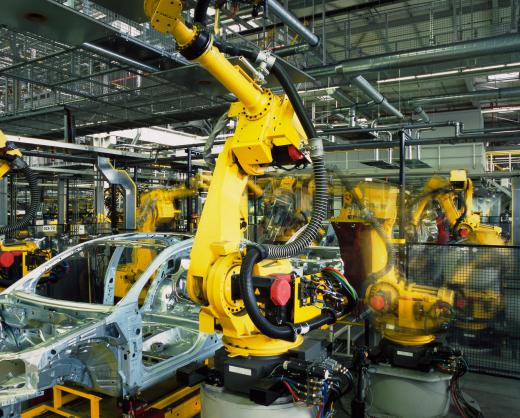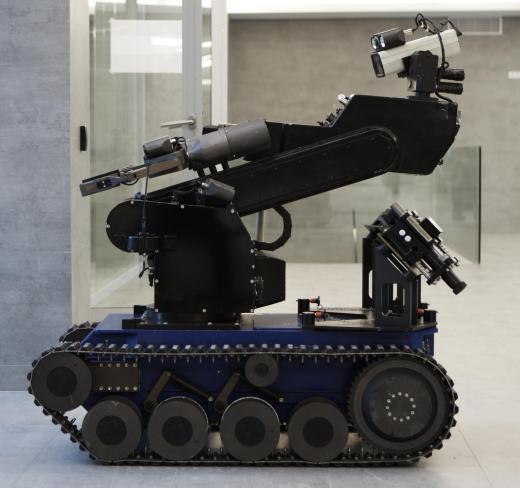What is the History of Robotics?
 Michael Anissimov
Michael Anissimov
The concept of robotics dates back to the Ancient Greeks at least. Greek mythology had at least one instance of robots, as the mechanical servants of the Greek god of technology, fire, and the forge, Hephaestus. In another Greek myth, Pygmalion, a master sculptor from Cyprus, crafts a statue named Galatea that comes to life. Around 350 BC, a brilliant Greek mathematician, Archytas, built a mechanical bird, "the Pigeon," that could fly through the air on steam power. This is one of the first known milestones in the development of the field, as well as the first recorded model airplane.
Many centuries later, in the late 1700s and early 1800s, the Industrial Revolution hit. This was fueled by steam power and extensive automation, especially in the production of textiles. The automated loom, invented in 1801, operated using punched card input. A couple decades later, in 1822, Charles Babbage introduced a prototype of his "Difference Engine" to the Royal Astronomical Society in Britain. Inspired by the automated loom, this machine also operated based on punch cards, but Babbage died before a production model could be built. Today, Babbage is known as the "Father of Computing," and all robots use computers for their "brains."

The modern era of robotics begins around 1959, when John McCarthy and Marvin Minsky established the Artificial Intelligence lab at MIT. A couple years later, Heinrich Erst created the first modern robotic hand, and in 1962, Unimate, the first industrial robot, was created to perform repetitive or dangerous tasks on the assembly line of General Motors. In 1966, the Stanford Research Institute created Shakey, the first mobile robot to know and react to its own actions. In 1967, Richard Greenblatt wrote MacHack, the first chess-playing program, in reaction to an article by Herbert Dreyfuss that argued that a computer would never beat him at chess.

The next few decades saw additional developments in robotics. Stanford University built the Stanford cart, an intelligent line-follower, in 1970, and in 1974 Victor Scheinman created the Silver Arm, an arm capable of assembling machines from small parts using touch sensors. Further advances occurred in 1977, when NASA launched the highly automated Voyager probes to explore the outer solar system.

The cutting edge of robotics continued to refine the speed and precision of robotic manipulators while creating prototypes of humanoid robots. In 1986, Honda started a humanoid robotics program, being represented by the prototype ASIMO, which had 11 versions from 1986 through 2008. In 2008, the robot had advanced to the point of being able to follow along with a human by holding hands, recognize its environment, distinguish sounds, and observe moving objects.
AS FEATURED ON:
AS FEATURED ON:














Discussion Comments
@SkyWhisperer - I just watched this video on the Internet for the world’s first “personal” robot. It uses an LCD screen for facial expressions and glides along on wheels at only 5 feet high.
It’s really freaky! It looks like something out of the Pixar 3D films. This kind of thing is already here, but I don’t know how much it costs. In the end it's price that will determine if it’s really ready for the mass market.
One of the most challenging tasks for robotic engineering has been to make the robots as humanoid as possible. I was watching a documentary on this the other day, and it was talking about how hard it is just to get robots to walk up and down steps without falling down. As humans we take the simple act of walking for granted, but for robots it’s a feat of engineering. It involves a lot of balancing and shifting of weight.
Some big companies like Google, Honda and Apple have made their own humanoid-type robots, but they are basically taking baby steps in comparison to what you see in the science fiction movies. It will be awhile before we see something like “C3PO” from Star Wars.
Robotic technology is being made increasingly accessible to the average hobbyist. Hobby robotics consists of “LEGO”-like building blocks that can be pieced together and manipulated with mechanical parts.
Hobbyists can buy these kits and hook up their robot creations to their computers, making it possible to send commands to the robots using a scripting like programming language. It’s a great introduction to robotic technology, and educators sometimes use these kits to teach their students about robotics and elementary computer programming.
Post your comments